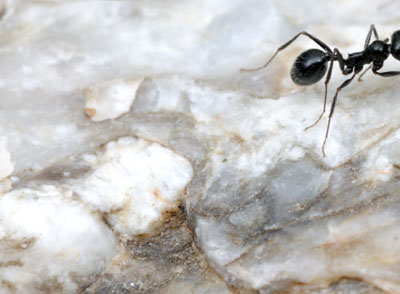
If you've ever spent time photographing ants the above shot will look familiar: off-frame and out of focus. Because ants are small and speedy, they are among the most difficult insects to photograph. Just capturing an active ant somewhere in the frame can be regarded as an achievement, never mind the more aesthetic concerns of lighting and composition. Yet ants are dominant insects nearly everywhere, and photographers who neglect them are missing out on one of our most important animals. Figuring out how to photograph these tricky insects is well worth the effort. If you can shoot ants, you can shoot almost anything.
Most techniques for photographing ants involve convincing them to stay put long enough to line up a shot. Below I share some of the tricks I have found most useful.
1. The Nest Entrance Trick
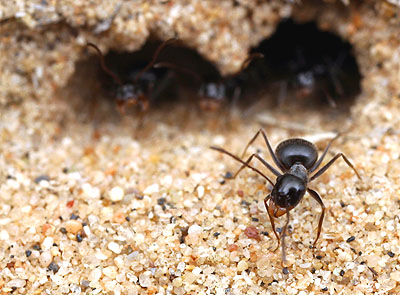
Ants often pause for a second or two when they first emerge into the light, as if testing the water before jumping. When shooting ants at their nest, we have the luxury of lining up a well composed shot on a stationary insect. As an added bonus, we also get a shot of natural behavior in the ants' normal habitat. Of course, making the most of the nest entrance trick entails learning where particular species nest and what time of day they are most active.
2. The Food Trick

Like the rest of us, an ant won't pass up free lunch. You can shoot for as long as the droplet of honey lasts.

A variation on feeding the ants is staking out a natural food source. This may be less predictable and more time-consuming, but the resulting shots capture real-world ant behavior. Plant nectaries, aphids, scale insects, lycaenid caterpillars, and even bird droppings can serve as natural ant-bait. The above image shows Forelius workers feeding at a cactus nectary.
3. The Time-Out Trick
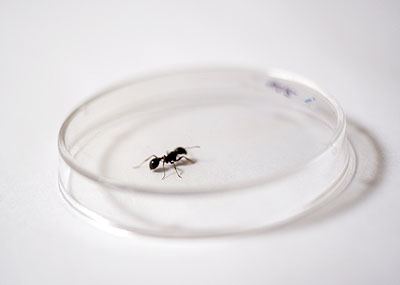

A frantic ant can be calmed by a bit of sensory deprivation. Placing an ant under a petri dish keeps the air currents down and allows her to settle in. Even better than a petri dish is something that blocks light. A lens cap works great. Let the ant sit in the dark for a few minutes and she'll shut down. Once you remove the cover you should have a few seconds before the ant perks up and starts running. I repeated the time-out trick about 20 times with this Cephalotes and a lens cap to get 5 useable shots.
4. The Pet Ant Trick

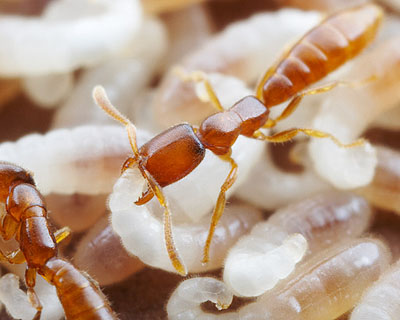
Keeping a captive colony on hand isn't itself a photographic technique, but if you'd like detailed shots of behavior within an ant nest then a pet ant colony is the only way to do it.
5. The Desert Oasis Trick

Ants- even desert ants- require some amount of humidity. When ambient conditions are dry they will seek out moisture. A drop of water soaked into a dry stone makes a little oasis for thirsty ants, and they will settle comfortably down over the droplet. Of course, this trick is most effective in arid climates. It's great where I live in Arizona, but I wouldn't count on it in, say, Florida.
6. The Angry Ant Trick

Here is a case where knowledge of ant behavior is helpful. Different kinds of ants will do different things when alarmed. Many, like Pheidole, will just run about willy-nilly. There's not much to be done with that sort of response. Other ants show more photogenic alarm behaviors. A few play dead, while others get their guard up. Many Formica, for example, will adopt a stereotypical defensive position if bothered near their nest. They tuck their gaster forward under their body, ready to fire a stream of formic acid if provoked further. Not only does the defensive posture slow them down enough to photograph, their aggression makes for some great action shots.
7. The Exhausted Ant Trick
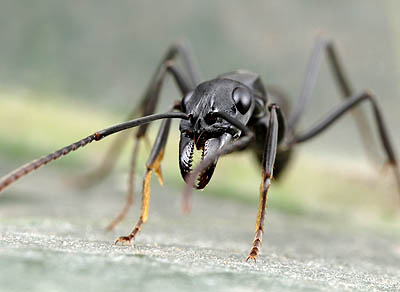
No one can run forever. If you've got patience, you can tire out an ant. I made this tropical Pachycondyla run about on a leaf for fifteen minutes by turning the leaf over and over like a treadmill. After she'd had enough she sat still for a portrait. This is more a trick of last resort. On more than one occasion a tireless ant has outlasted me; it's hard to tell ahead of time how long it will take.
8. Go With The Flow

If the ants won't sit still, you may as well take advantage of the constant motion. Pan the camera parallel to the ground at the same speed as the ants. A long exposure will blur the background while giving a sense of movement to the image. For any given situation I experiment with many different exposures, but with the right settings the results can be dramatic.
As a final note I'll say what I don't do very often: chill an ant in the fridge. Chilled ants do slow down, but they often look...wrong. They hold their legs at odd angles and get telltale spots of water condensing on their bodies. Letting an ant calm down on her own terms results in much more natural photos.

Great! Thanks..
I never imagined the difficulties one would face trying to photograph ants! As an artist who works by hand, I don't always have the respect for photography that I should have. You give us some great tips and great shots, I applaud you! Really great close-ups with some great texture, these photos are truly fantastic. -Ed
Great Topic and of course great pictures.
I have one more to add. For some species which are very bad climber, I have developed this technique in the lab on white paper but that could work also with a leaf.
The idea is simple: take a piece of Styrofoam or any kind of thing that can be used as a base, then pierce a long and narrow small piece of paper carton or leaf with a needle.
Plant the needle in the base, but keep enough space to don't let the ant to go down the paper directly.
Some species will stay on the upper face and after a while some individuals will stop moving.
Some other species will go on the lower face of the paper. If the paper is narrow enough, in that case the ants will be easy to find and you will have enough deep of field to have good shots.
I use this technique usually with small species that respond pretty well to it.
For the lower face shoots, finally, a simple rotation of 180 degree will give the impression that the ant was on the "good side"
These are great tips and very helpful as I have often failed in attempts to get good ant shots. It certainly sounds like knowing more about ant behavior will help get better shots. Do you know of any books that will help here (particularly something that talks about ants in the US or the West Coast)?
Currently I am reading "Journey to the Ants", which is very interesting but is more general.
Great tips! I like the one about tiring them out.
Thanks guys!
Benoit- yours sounds like a very useful techinique. I look forward to trying it out.
Calevphoto- You might want to try Fisher & Cover's "Ants of North America". Also, for your part of the country Jack Longino's page on the Ants of the Evergreen College Campus will help sort out your most common species.
Amazing pictures. Ants certainly come in a wide variety of shapes!
Nice! I was poised to try a chill plate, but first will try some of these techniques with Turkestan and Desert cockroaches. They seem to do nothing but scuttle about continuously looking for shelter.
hi
Cool pictures. I think this was hard work to make all these shoots.
I'm amazed and impressed with the photos, and appreciate knowing how they were taken. I am sharing the photos with my graduate class on insect-plant interactions (with credit to Alex Wild, of course!). Thank you SO much for sharing them!
I love watching ants...they are so amazing
Thanks for the tips.
I wonder if any of these photography tricks would work on toddlers . . . . hmmmmm.
Scottshots Photography
www.scottshots1.com
Invaluable information. Thanks for putting it out there!
fifteen minutes by turning the leaf over and over... hehehe thats kind desperate like "i want a picture of you, not other ant, just you!" hehehe
Great tips! Gracias.
Another bait I've found really works is spit. I always got it with me, and many species love it. For example http://anthopper.smugmug.com/photos/345715262_H3mty-L.jpg
Kit